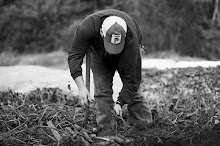Applying
Permaculture:
Building a farm & homestead from scratch on marginal land.
Susana Kaye
Lein, SALAMANDER SPRINGS FARM,
Berea, KY
Permaculture (a permanent culture or agriculture):
Developed in the late 1970's by
Australians Bill
Mollison and David
Homgren,
permaculture is a design system for human
environments-farms, housing, business and communities-that are locally-sustained. Natural ecosystems
provide a model for
permaculture. Energy needs are generated, saved, wisely used and recycled within the system.
The principles of
permaculture are useful to organic farmers, homesteaders, urban gardeners and local businesses. Often we tend to mimic conventional methods, making the land yield by brute force and using external energy resources and protracted, tedious labor.
Permaculture teaches us to develop energy-sustaining connections between our land, resources, built environments and communities.
PERMACULTURE DESIGN
PRINCIPLES for food and shelter:
1) Design systems that mimic patterns & relationships found in natural systems.
a- Create
diversity rather than segregated, forced simplicities.
b- Work creatively with plant succession and system changes.
c- Build soil UP and keep it covered.
d- Produce no waste- close the loop! Natural systems produce no waste:
One organisms by-products are
another's food.
2) Provide and recycle energy & nutrient needs on the site or within the community.
a- Catch and store energy from renewable resources.
b- Develop and utilize local resources (nutrients, labor, materials, money, etc.)
c- Convert problems into opportunities & resources. "The problem is the solution."
3) Every situation is different. Apply principles, not formulas.
a- Learn from feedback. Self-regulating systems have positive energy feedback
b- Share what we learn from others.
4) Integrate rather than segregate. Rather than single product systems, develop mutually cooperative or symbiotic relationships between elements: Plants, gardens, pond, pasture, field, house, fences, forest, orchard, animals, barn, chicken house, greenhouse, etc.:
a- Make each element (plant, animals, structure, etc.) perform multiple functions.
b- Fulfill each need by several elements in the system.
c- Locate and link elements to provide efficient, beneficial interchanges of these functions.
___________________________________________________________________
SOME GUIDELINES THAT HELP:
Distinguish "needs" from "wants". Save your money towards your goals.
Instead of buying from corporate chains, buy local or used, scavenge or create your own alternatives. Create a "free foods exchange" spot in your community; put out the word for materials you need.
Create community: Barter your skills and goods for those which you need. Ask for help and share what you learn. Create your own workshops or workdays.
If you
don't know how to do something - research, start anyway and learn by doing.
Volunteering is a great way to learn skills.
Use
permaculture principles for all aspects of life.
Plant trees and perennials first - for food, fuel, fiber and to mitigate effects of global warming.
Work is love made real. Do the work that you love.
"Do the best that you can in the place that you are...and be kind. - Scott Nearing
Susana is an amazing person and sustainable farmer using
permaculture practices at her farm; Salamander Springs Farm in
Berea, KY -
www.localharvest.org/farms/M5606I had the pleasure of meeting her and attending her
permaculture workshops.
One was given at the annual
Biodynamic conference; Long Hungry Creek Farm, Red Boiling Springs, TN. The other was at the Carolina Farm Stewardship Association's annual Sustainable Agriculture conference.
___________________________________________________________________
SUGGESTED PERMACULTURE REFERENCE BOOKS:
Introduction to Permaculture, Bill Mollison and Reny Mia Slay
Permaculture: Principles & Pathways Beyond Sustainability, David Holmgren
Gaia's Garden: A Homescale Guide to Permaculture, Toby Hemenway
Humanure Handbook: A Guide to Composting Human Waste, Joseph Jenkins.
Seed to Seed, Suzanne Ashworth.
Permaculture: A Designer's Manual, 576 pages!, Bill Mollison.
Edible Forest Gardens: Ecological Design & Practice for Temperate Climate PermaculturePlants for a Future: Edible and Useful Plants for a Healthier world, Ken Fern.
QUARTERLY "HOW-TO" PUBLICATIONS:
Permaculture Activist magazine,
www.permacultureactivist.netThe Natural Farmer, Northeast Organic Farmers Association,
www.nofa.org



